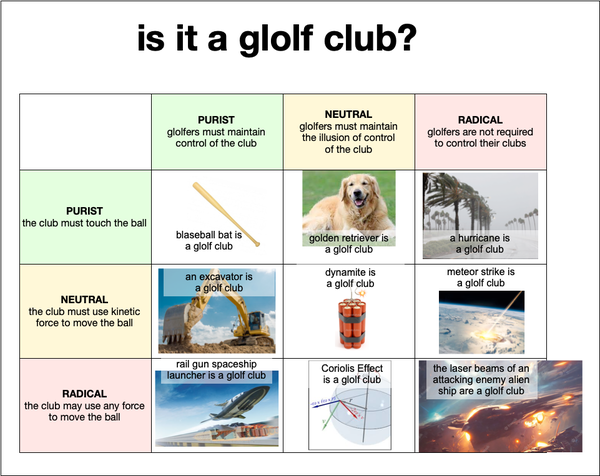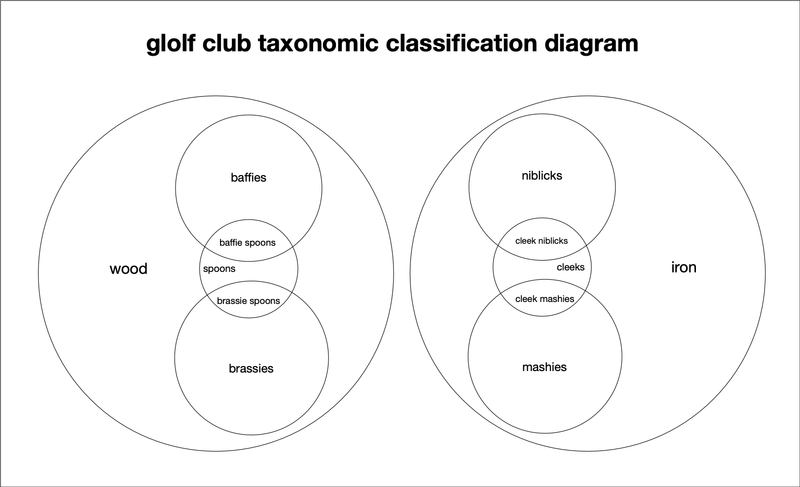Difference between revisions of "Clubs (implement)"
m (→Cleeks) |
|||
| (7 intermediate revisions by the same user not shown) | |||
| Line 24: | Line 24: | ||
* '''Bone''' glolf clubs | * '''Bone''' glolf clubs | ||
* '''Denim''' glolf clubs | * '''Denim''' glolf clubs | ||
| + | * '''Ultra-Dense Fractionated Isotope''' glolf clubs | ||
===Number=== | ===Number=== | ||
| − | Glolf clubs are further classified by their number, an attribute that every glolf club has when it is created. | + | Glolf clubs are further classified by their number, an attribute that every glolf club has when it is created. As with glolf material, traditional glolf clubs fall under two categories: |
| − | + | * small-number (lower density) | |
| + | * large-number (higher density) | ||
| − | + | However, it has been observed that some clubs have numbers that drift over time, or have oscillating numbers. In some rare cases, glolf clubs have changed numbers mid-match, affecting the outcome of important tournaments. | |
| − | + | ||
| + | ===Traditional versus Radical Interpretations=== | ||
| + | |||
| + | Debate over what constitutes a glolf club has gone on for as long as glolf has been a splort - possibly longer. The following is a helpful chart provided by the International Coalition of Concerned Glolf Scientists for people to refer to when arguments over glolf clubs get out of hand: | ||
| + | |||
| + | [[Image:Glolf Club Alignment Chart.png|600px]] | ||
==List of Glolf Club Types by Name== | ==List of Glolf Club Types by Name== | ||
| + | |||
| + | [[File:Glolf Club Taxonomic Classification.png|thumb|right|800px|Glolf club taxonomic classification chart]] | ||
===Baffies=== | ===Baffies=== | ||
| − | A '''baffie''' glolf club | + | A '''baffie''' glolf club is a club that is made of wood and is large-number. |
===Brassies=== | ===Brassies=== | ||
| Line 55: | Line 64: | ||
===Niblicks=== | ===Niblicks=== | ||
| + | |||
| + | A '''niblick''' glolf club is a club that is made out of iron and is large-number. | ||
===Spoons=== | ===Spoons=== | ||
| + | |||
| + | A '''spoon''' glolf club is a wooden glolf club featuring a concave face. | ||
| + | |||
| + | A spoon can be further classified as a '''brassie spoon''' (small-number spoon) or a '''baffie spoon''' (large-number spoon). | ||
Latest revision as of 19:18, 5 February 2023
For other uses, see Clubs (disambiguation).
A glolf club is an implement used to play glolf. A glolf club is characterized by a material and a number. Some glolf clubs, like famous swords, have earned nicknames and are woven into glolf lore.
Glolf Club Classification
Glolf clubs are classified by their material and number, as prescribed by a strict hierarchical taxonomy carefully crafted and maintained by a collective of glolf biologists. The taxonomy was developed in the early days of glolf and has been refined and handed down over many generations of biologists.
There is intense debate within the glolf biology community and among the wider glolf community about what, exactly, constitutes a glolf club. However, glolf traditionalists classify glolf clubs according to two dimensions: material, and number.
Material
Traditionally, glolf club materials were limited to two types:
- Wood clubs are high in entropy and are principally used in situations where unpredictability and chaos is desirable; glolfers often resort to wood clubs early in matches, or when attempting desperate come-from-behind wins
- Iron clubs are low in entropy and principally used in situations where precision and accuracy are critical; glolfers will utilize iron clubs in situations where they know precisely what is needed for their shot, in terms of distance, angle, wind, etc.
More recently, amateur glolf enthusiasts in the Core have begun to experiment with non-traditional glolf club materials, including:
- 3D Printed glolf clubs
- Meat glolf clubs (specifically Bacon clubs)
- Fire glolf clubs
- Aluminum glolf clubs
- Bone glolf clubs
- Denim glolf clubs
- Ultra-Dense Fractionated Isotope glolf clubs
Number
Glolf clubs are further classified by their number, an attribute that every glolf club has when it is created. As with glolf material, traditional glolf clubs fall under two categories:
- small-number (lower density)
- large-number (higher density)
However, it has been observed that some clubs have numbers that drift over time, or have oscillating numbers. In some rare cases, glolf clubs have changed numbers mid-match, affecting the outcome of important tournaments.
Traditional versus Radical Interpretations
Debate over what constitutes a glolf club has gone on for as long as glolf has been a splort - possibly longer. The following is a helpful chart provided by the International Coalition of Concerned Glolf Scientists for people to refer to when arguments over glolf clubs get out of hand:
List of Glolf Club Types by Name
Baffies
A baffie glolf club is a club that is made of wood and is large-number.
Brassies
A brassie glolf club is a club that is made out of wood and is small-number.
Cleeks
A cleek glolf club is an iron glolf club featuring a concave face.
A cleek can be further classified as a cleek mashie (small-number cleek) or a cleek niblick (large-number cleek).
Mashies
A mashie glolf club is a club that is made out of iron and is small-number.
Niblicks
A niblick glolf club is a club that is made out of iron and is large-number.
Spoons
A spoon glolf club is a wooden glolf club featuring a concave face.
A spoon can be further classified as a brassie spoon (small-number spoon) or a baffie spoon (large-number spoon).

